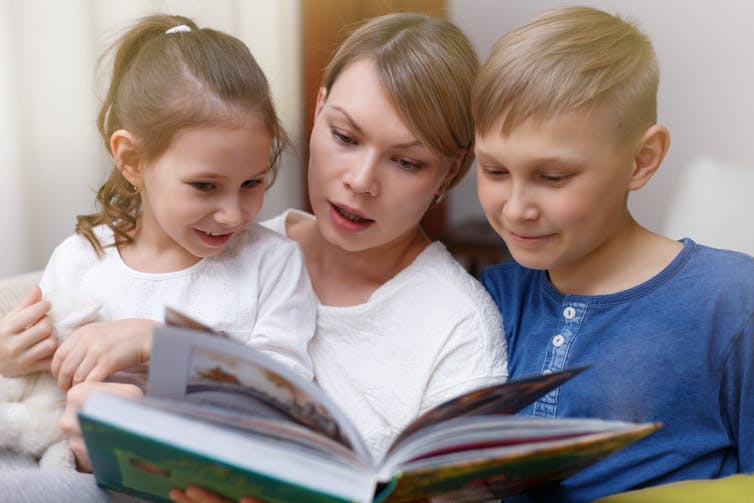Research shows the importance of parents reading with children – even after children can read

Many of us will be able to recall the enjoyment of shared reading: being read to and sharing reading with our parents. However, my research has found that of the 997 Year 4 and Year 6 respondents at 24 schools who took part in the 2016 Western Australian Study in Children’s Book Reading, nearly three-fifths reported that they were not being read to at home.
A sample of these children also participated in interviews, where I asked them how they felt about shared reading. While a few children did not mind no longer being read to, others were disappointed when it stopped. For example, when I asked Jason about his experience of being read to by his parents, he explained:
… they kind of stopped when I knew how to read. I knew how to read, but I just still liked my mum reading it to me.
His experience is common, with other recent research suggesting that more than one-third of Australian respondents aged six to 11 whose parents had stopped reading to them wanted it to continue.
But why is it so important for us to keep reading with our children for as long as possible?
Research has typically found that shared reading experiences are highly beneficial for young people. Benefits of shared reading include facilitating enriched language exposure, fostering the development of listening skills, spelling, reading comprehension and vocabulary, and establishing essential foundational literacy skills. They are also valued as a shared social opportunity between parents and their children to foster positive attitudes toward reading.
When we read aloud to children it is also beneficial for their cognitive development, with parent-child reading activating brain areas related to narrative comprehension and mental imagery. While most of the research in this area focuses on young children, this does not mean that these benefits somehow disappear as children age.
As young people’s attitudes towards reading reflect their experiences of reading at home and at school in childhood and beyond, providing an enjoyable shared reading experience at home can help to turn our children into life-long readers.
However, not all shared reading experiences are enjoyable. Some children described having poor quality experiences of being read to, and children did not typically enjoy reading to distracted or overly critical parents. In some cases, parents attempted to outsource this responsibility to older siblings, with mixed results.
While many children really enjoyed the social aspects of reading and being read to as valuable time with their parents, they also felt that they learned from these experiences. For example, listening was felt to provide an opportunity to extend vocabulary, and improve pronunciation. Gina recalled the advantage she lost when her parents stopped reading to her, as:
… when they did read to me when I was younger, I learnt the words; I would like to learn more words in the bigger books and know what they are so I could talk more about them.
Similarly, Craig explained how being read to enabled his academic advantage in literacy, as “they were teaching me how to say more words”, and “that’s why I’m ahead of everyone in spelling and reading and English”. When this stopped “just because my mum thought I was smart enough to read on my own and started to read chapter books”, Craig was disappointed.
In addition, children were sometimes terrified of reading aloud in the classroom, and this fear could potentially be alleviated through greater opportunities to practice at home.
Hayden’s anxiety around reading aloud at school related to his lack of confidence, and his tendency to compare his skills with those of his peers. He described himself as “always standing up there shivering, my hands are shivering, I just don’t want to read, so I just start reading. And I sound pretty weird”. No-one read with him at home, so he had limited opportunity to build his confidence and skills.
This research suggests that we should not stop reading with our children just because they have learned to read independently.
We should continue reading with our children until they no longer wish to share reading with us, ensuring that these experiences are enjoyable, as they can influence children’s future attitudes toward reading, as well as building their confidence and competence as readers. It is worth the effort to find time to share this experience with our children in the early years and beyond.![]()
Margaret Kristin Merga, Senior Lecturer in Education, Murdoch University
This article is republished from The Conversation under a Creative Commons license. Read the original article.